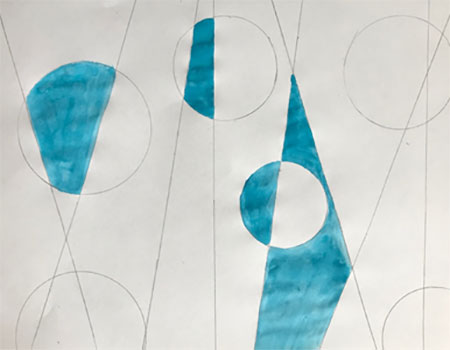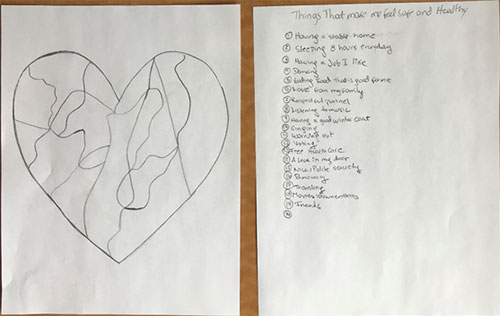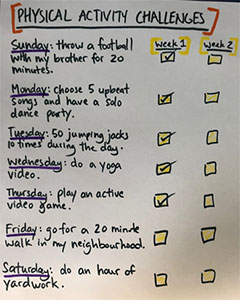Human rights - day 2 safe and healthy
These activities will help youth learn about human rights and their guiding principles, like “Safe and healthy”. They can be done alone, but work best with one or more friends on a video chat like Skype, Zoom, Facetime, etc.
Grades K-3
Grades K-3
Mindfulness Activity
Trivia question: Which planet in our Solar System is known for having a ring?
Mindfulness Activity:
- Imagine that your pointer finger is a candle.
- Hold up your candle, take a deep breath in, then blow out the candle on your finger for as long as you can.
- Notice how your breath fills up your belly when you breathe in.
The Right to Health and Wellbeing
Help keep yourself and others safe by learning and memorizing a few emergency phone numbers. With your child, practice new ways to remember emergency contact numbers. For example:
- Practice repeating the numbers before bed or during bath time each night
- Create an emergency phone book and keep it in your child’s backpack
- Create a list and save it to your child’s phone/tablet
- Create a poster with the numbers and place it on your wall – practice remembering these numbers often
- Learn who to contact in an emergency
Have your child think of three people who they could call in an emergency (for example, if they were lost or needed a ride home).
Write down their names and phone numbers on a piece of paper.
Quiz your child the next day to see if they can remember who to contact.
The Right to Nutritious Food – Building with Veggies
Help keep yourself and others safe by learning and memorizing a few emergency phone numbers. With your child, practice new ways to remember emergency contact numbers. For example:
- Practice repeating the numbers before bed or during bath time each night
- Create an emergency phone book and keep it in your child’s backpack
- Create a list and save it to your child’s phone/tablet
- Create a poster with the numbers and place it on your wall – practice remembering these numbers often
- Learn who to contact in an emergency
Have your child think of three people who they could call in an emergency (for example, if they were lost or needed a ride home).
Write down their names and phone numbers on a piece of paper.
Quiz your child the next day to see if they can remember who to contact.
The Right to Clean Water – Fruited Water Drinks
Supplies:
- Large jug or pitcher
- Different fruits or vegetables
All children have the right to clean water for drinking. This is outlined in the United Nations Convention on the Rights of the Child, in Article 24. The recommended daily amount of fluid for a 5-8-year-old is 5 glasses and 7 glasses for 9-12 year-olds.
- Fill a large jug or pitcher with water, keeping in mind the recommended amount for your family.
- Add a fruit or vegetable to lightly flavour the water. This will make it more refreshing and more appealing to drink.
Here are some examples of fruit or vegetables you can add:
- Orange slices
- Watermelon
- Cucumber
- Strawberry slices
Talk to your child about the importance of drinking water. Try a couple of different flavours, then ask your child which fruit was their favourite. How did the fruit change the taste of the water? Did it make it more sweet or sour?
Review Questions
Ask your child:
- How does it feel to eat nutritious food and drink enough water in a day?
- Why do you think children have a right to good food and water?
- What can you do to stay healthy?
Trivia answer
Answer: Saturn
Grades 4-6
Grades 4-6
Mindfulness Activity
Trivia question: When was the Canadian Charter of Rights and Freedoms created?
Mindfulness Activity:
- Find your pulse on your neck or your wrist.
- Count how many times your heart beats for 15 seconds. (Get help from a parent or use a timer)
- Now breathe fast 10 times.
- Take your pulse again.
- Which one was higher?
Kids’ Resource Book
Supplies:
- Paper
- Marker/ Pencils/ Crayons
All kids have the right to be alive. You have the right to have good physical, mental and emotional health. You also have the right to intellectual, social and cultural development. This is listed in the United Nations Convention on the Rights of the Child, in Article 6.
- Fold a stack of four or five blank pieces of paper in half. Staple down the folded edge to create a booklet.
- Have your child make a cover page that says, “Kids’ Resource Book”.
- Research and collect information about places that are meant to help kids stay safe and healthy. These could be organizations that work to protect children in your community, emergency numbers in your area or safe places children can go in your community.
- Add information about these resources into the booklet.
- Draw pictures, and add colours and borders.
Pattern Drawing
Supplies:
- Blank paper
- Pencil
- Watercolor
- Paintbrush
- Ruler
- Circular objects (e.g. round container lids)
You have the right to rest. Creative activities can help us relax and be in the moment.
- Have your child draw 12 -16 straight lines across the paper from one edge to the other. They can go in any direction.
- Place your circular objects on the page and trace them. Your child can add as many as they want.
- Use watercolor paints (or crayons, pencil crayons or markers) to fill in the spaces with colour.

Health and Safety Map
Supplies:
- Paper
- Marker/ Pencils/ Crayons
Have your child write down their answers to the following questions on a piece of paper:
- What is safety?
- What is physical safety?
- What is mental safety?
- What does safety look like?
- How do you feel when you are safe?
- What does it mean to be healthy?
- What things can I do to be healthy?
On a separate piece of paper, draw a large outline of a heart. Divide the inside of the heart into sections. Label each section with one thing that is important for safety and health. Add colour and pictures. This is a health and safety map. It is a visual reminder of all the things that makes us safe and healthy.

Debrief Questions
Ask your child:
- How does it feel to take care of your emotional health?
- Why do you think it is important for kids to have the right to play?
- What are some things you can do to be healthy?
Trivia answer
Answer:1982
Grades 7+
Grades 7+
Mindfulness Activity
Trivia Question: How many muscles does a cat have in each ear? See mindfulness activity answer at the end of the lesson plan.
A: 2
B: 32
C: 47
Mindfulness Activity:
- Put your palms together at chest height.
- Push your hands against each other as hard as you can.
- Which muscle gets tired first?
Right to Life
Supplies:
- Pencil
- Paper
- Markers
Youth have the right to be alive. That means you should get the care you need to be physically, mentally and emotionally healthy. You should also get care for your intellectual, social and cultural development.
Think of the things you have that help towards your rights listed below. For example, social development is supported by calling a family or friend to check in. Try to come up with one or two activities you do to support your right to life and why all of these are important to our survival.
- Physical health
- Mental health
- Emotional health
- Intellectual development
- Social development
- Cultural development
Create images that show how you celebrate your right to life, survival and development with your emojis.
- Use a piece of paper to draw an emoji for each point. Write down what they mean to you. For example, what does it mean to you to be able to call a family member or friend to check in?
- You could find a phone emoji or two people talking to show “social development”.
Be creative. Draw out your images with all the headings on a piece of paper. Then share with your family and friends what you have created.
Where I Live
Supplies:
- Pencil
- Paper
- Markers
Think about your home and the neighborhood you live in. Draw a map of your neighbourhood that includes places that are important to you and your family. You could include places like:
- Your home
- Your school
- The mall
- A library
- Your bus stop
- Community centres
- Parks
- Recreation facilities
- A place of worship
Use some colours and take the time to map out your neighborhood. Try to add as many things as you can to fill out your neighborhood map.
Look at the list below on child and youth rights. Choose 5 rights that are important to you and write them down at the top of your map. Add drawings that represent these rights in the places you included on your map.
List of Child and Youth Rights:
- Right to life
- Right to express oneself
- Right to go to school
- Right to practice religion
- Right to medical care
- Right to food
- Right to play
- Right to rest
- Right to security
- Right to privacy
- Right to equality
- Right to choose my friends
- Right to information
- Right to a name
- Right to live with my parents
- Right to a clean environment
- Rights of children with a disability to participate
Right to be Physically Healthy
Supplies:
- Paper
- Pencil
- Markers
Our physical health is important. Especially while we may not have access to places where we usually stay active.
- Draw a weekly calendar with the days of the week.
- For each day, create a physical challenge. For example, do 25 jumping jacks 25 times throughout the day.
- Come up with other physical activities you can do at home.
- Every day you complete a challenge, put a star on your calendar.
- The following week, repeat your challenges and challenge a friend or family member to join you.

Review Questions
- Why do you feel the rights to life, survival and development are so important?
- What did you think about your community when you mapped out your locations with your rights?
- Which activities were difficult for you to complete in the physical challenge?
Trivia answer
Answer: B: 32

